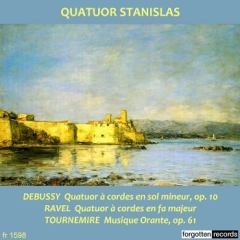The Quatuor Stanislas and its expanded ensemble has been active now for a quarter of a century and as I remarked in a previous review their repertoire is strongly predicated on French music. This is hardly surprising given their base in Nancy, but these affiliations are sure and secure and have been evidenced on disc in their readings of Ropartz’s set of String Quartets (the first ever complete recording) and in music by Schmitt, Emmanuel, Cartan, Thirion and Sauguet. Now here comes the ultimate pairing of French quartets with the added attraction of a little-known but not insubstantial work for the medium by Charles Tournemire.
The newer recordings are the Debussy and Ravel works where Marie Triplet (good name for a musician) is the violist, replacing Paul Fenton who was the quartet’s violist in the 2008 Tournemire recording. The other members of the group are unchanged: Laurent Causse and Bertrant Menut, violins, and cellist Jean de Spengler. Their Debussy is well sprung at good tempi. There is sufficient flexibility of rubato to lean into and exploit but not prolong phrases, especially in the first movement, which is taken at a forward-moving tempo. The pizzicatos come across with detonatory force in the scherzo – and the dynamics are well varied – and they vary vibrato speed and width in the slow movement to good effect. Applause has been retained. They performed the Ravel at the same concert and judge its variety of moods sensitively. There’s a warmly shaped B section in the scherzo and a lively but controlled finale, after which applause is again retained.
Tournemire’s Musique Orante, Op.61 dates from 1933, six years before the composer’s death. Its rather tentative beginnings emerge at a reflectively slow tempo and in places with organ-like sonority. The music generates increasing speed and tension and makes for a well-judged return to the introspective elements that opened the work. This is a fine, excellently sustained reading of a work that has been recorded commercially but makes for more than a mere pendent to the Debussy-Ravel brace.
As with all the Stanislas recordings I’ve encountered from Forgotten Records, there is a biography of the ensemble in the booklet in both French and English.
Jonathan Woolf


